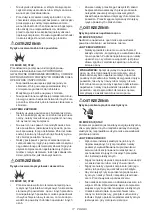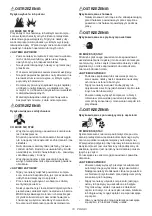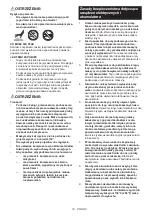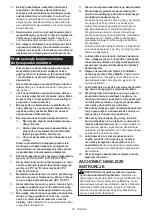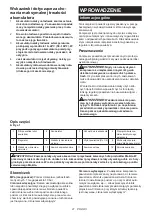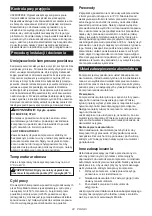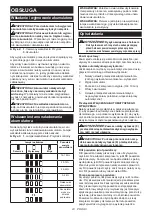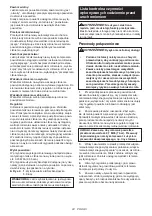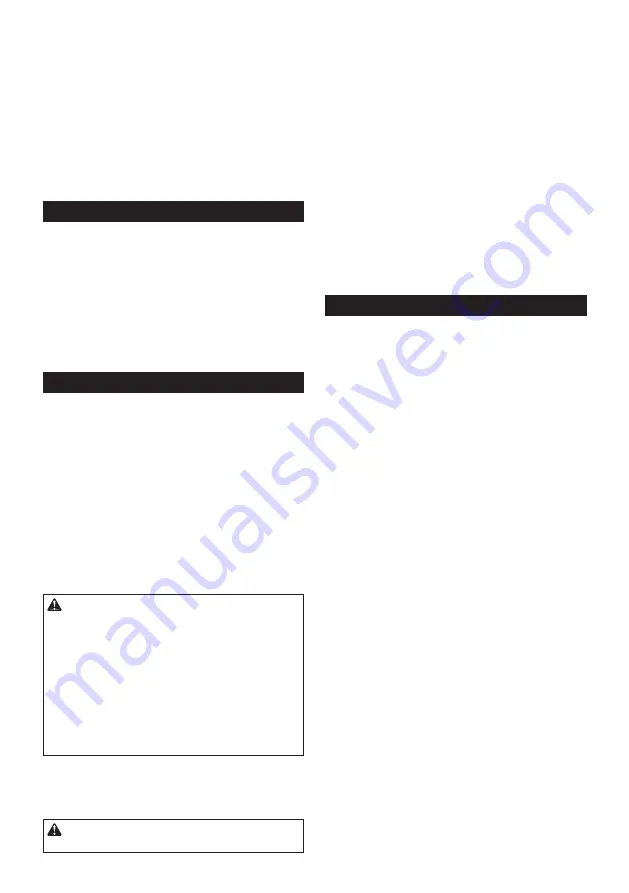
9 ENGLISH
Glossary
MPa (megapascal):
Metric pressure measurement. 1
megapascal equals to 10 bar.
Cut-in pressure:
While the motor is off, air tank pressure
drops as you continue to use your accessory or air tool.
When the tank pressure drops to a certain level the motor
will restart automatically re-started is called “cut-in pressure”.
Cut-out pressure:
When you turn on your air compres-
sor, it begins to run, air pressure in the air tank begins
to build. It builds to a certain pressure before the motor
automatically shuts off - protecting your air tank from
pressure higher than its design rating. The pressure at
which the motor shuts off is called “cut-out pressure”.
On-receipt inspection
DAMAGE: Each air compressor outfit is carefully tested
and checked before shipment. With improper handling,
damage may result in transit and cause problems with
compressor operation.
Immediately upon arrival, check equipment for both
concealed and visible damages to avoid expenses
being incurred to correct such problems. This should be
done regardless of any visible signs of damage to the
shipping container. If this product was shipped directly
to you, report any damages to the carrier and arrange
for inspection of goods immediately.
Installation and break-in procedures
Location of the air compressor
Locate the air compressor in a clean, dry and well-ven-
tilated area. The air filter must be kept clear of obstruc
-
tions, which could reduce air delivery of the air compres-
sor. The air compressor should be located at least 305
mm away from the wall or other obstructions that will
interfere with the flow of air. The air compressor head
and shroud are designed to allow for proper cooling.
If humidity is high, an air filter can be installed on the
air outlet adapter to remove excessive moisture. Follow
the instructions packaged with the air filter for proper
installation.
Place the air compressor on a flat surface so that it is
resting securely on the rubber feet.
WARNING:
Risk of Falling
WHAT CAN HAPPEN
The air compressor can fall from a table, workbench,
or roof causing damage to the compressor and could
result in serious injury or death to the operator.
HOW TO PREVENT IT
Always operate compressor in a stable secure
position to prevent accidental movement of the com-
pressor. Never operate compressor on a roof or other
elevated position. Use additional air hose to reach
high locations.
Operating temperature
The operating temperature of this compressor is
between 0°C and 40°C.
CAUTION:
Never operate the compressor in
the temperatures below 0°C and above 40°C.
Duty cycle
All Makita manufactured air compressors are rec-
ommended to be operated on not more than a 50%
duty cycle. This means an air compressor that pumps
air more than 50% in one hour is considered misuse
because the air compressor is undersized for the
required air demand.
Piping
Plastic or PVC pipe is not designed for use with com-
pressed air. Regardless of its indicated pressure rating,
plastic pipe can burst from air pressure. Use only metal
pipe for air distribution lines. If a pipe line is necessary,
use pipe that is the same size, or larger than, the air
tank outlet. Piping that is too small will restrict the flow
of air. If piping is over 30.5 m long, use the next larger
size. Bury underground lines below the frost line and
avoid pockets where condensation can gather and
freeze. Apply pressure before underground lines are
covered to make sure all pipe joints are free of leaks.
Battery protection system
This compressor is equipped with a battery protection
system. This system automatically cuts off power to the
motor to extend compressor and battery life. The com-
pressor will automatically stop during operation if the
compressor/battery is placed under one of the following
conditions:
Overloaded
The compressor/battery is operated in a manner that
causes it to draw an abnormally high current. In this
situation, turn the compressor off and stop the applica
-
tion that caused the compressor to become overloaded.
Then turn the compressor on to restart.
If the compressor does not start, the battery is over-
heated. In this situation, let the battery cool before
turning the compressor on again.
Low battery voltage
The remaining battery capacity is too low and the
compressor will not operate. If you turn the tool on,
the motor runs again but stops soon. In this situation,
remove and recharge the battery cartridge.
Protections against other causes
Protection system is also designed for other causes that
could damage the compressor and allows the tool to
stop automatically. Take all the following steps to clear
the causes, when the compressor has been brought to
a temporary halt or stop in operation.
1. Turn the compressor off, and then turn it on again
to restart.
2. Charge the battery or replace it/them with
recharged battery.
3. Let the compressor and battery cool down.
If no improvement can be found by restoring protection
system, then contact your local Makita Service Center.

















